Insightful commentary
 Same Lyrics, Different Tune
Same Lyrics, Different Tuneby Father Jonathan Morris
Dedicated to the Restoration of a Catholic Identity
 Same Lyrics, Different Tune
Same Lyrics, Different Tune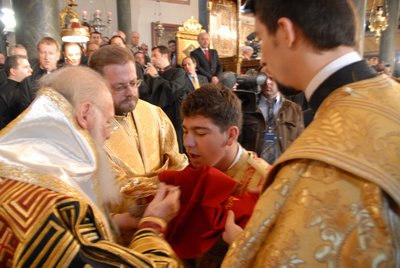
 Pope Benedict XVI and His All Holiness Ecumenical Patriarch Batholomew I at Divine Liturgy of Saint John Chrysostom in the Patriarchal Cathedral Church of Saint George, Istanbul, Turkey, on November 30, 2006, the Patronal Feast of Saint Andrew the First Called Apostle.
Pope Benedict XVI and His All Holiness Ecumenical Patriarch Batholomew I at Divine Liturgy of Saint John Chrysostom in the Patriarchal Cathedral Church of Saint George, Istanbul, Turkey, on November 30, 2006, the Patronal Feast of Saint Andrew the First Called Apostle. Rather than another Far Side, Dilbert or Garfield desk calendar for the mother-in-law this year, may I be so bold as to suggest Benedictus, an elegant volume of meditations for each day of the year taken from the exhortations of Pope Benedict XVI. Published by Magnificat and Ignatius Press, the book contains 416 illustrated pages with 721 details of sacred art: well worth the US$19.95. Visit http://www.magnificat.net to order.
Rather than another Far Side, Dilbert or Garfield desk calendar for the mother-in-law this year, may I be so bold as to suggest Benedictus, an elegant volume of meditations for each day of the year taken from the exhortations of Pope Benedict XVI. Published by Magnificat and Ignatius Press, the book contains 416 illustrated pages with 721 details of sacred art: well worth the US$19.95. Visit http://www.magnificat.net to order. Today is the Feast of Saint Andrew the Protokletos (First-called) Apostle. I took the name Andrew at Confirmation decades ago when Auxiliary Bishop of
Today is the Feast of Saint Andrew the Protokletos (First-called) Apostle. I took the name Andrew at Confirmation decades ago when Auxiliary Bishop of Of historical interest: In 357 the Emperor Constantine (son of Constantine The Great) ordered that the body of Saint Andrew be re-interred in the Church of the Holy Apostles in Constantinople [modern Istanbul.] With all the magnificence and honor of the
 We've had an unseasonal cold-spell this week in AZ. It's perfect weather for some good Mexican hot chocolate or albondigas. It must be a one-dog-night because Oreo, my whippet mix, has calmed down from his usual hyper-self and decided to snuggle up to me to keep warm. Who's keeping whom warm? Wish I had time to head up to Northern AZ where it's snowing.
We've had an unseasonal cold-spell this week in AZ. It's perfect weather for some good Mexican hot chocolate or albondigas. It must be a one-dog-night because Oreo, my whippet mix, has calmed down from his usual hyper-self and decided to snuggle up to me to keep warm. Who's keeping whom warm? Wish I had time to head up to Northern AZ where it's snowing.

ORALANDO, FL, November 27, 2006 (LifeSiteNews.com) - As part of the Friend or Foe Christmas Campaign, Liberty Counsel has created a "Naughty and Nice" checklist (available online in pdf or MSWord) which catalogs retailers who either censor or recognize Christmas. The list was compiled from information gathered by Liberty Counsel supporters.
Partial "Naughty List"
Lowe's - Employees cannot say "Merry Christmas" to customers. Lowe's corporate advised that only when customers initiate a "Merry Christmas" greeting can employees respond in kind.
Toys 'R' Us - "Holidays" are in, "Merry Christmas" is out.
Banana Republic - Web site has "Holiday Gift Guide" with no mention of Christmas.
Bed Bath & Beyond - No mention of any holidays.
Barnes & Noble - Web site says "Gift Guide," "Holiday gift baskets," "Holiday sled," "Holiday delivery," but no Christmas. Stores not allowed to put up Christmas trees, and employees are not allowed to say "Merry Christmas."
Best Buy - Web site says "Unique gifts for the season," "Holiday gift ideas." Spokesperson said the use of "Merry Christmas" is disrespectful.
Dick's Sporting Goods - Web site says "gifts" and has images, but no mention of Christmas.
Eddie Bauer - Customer service would not recognize Christmas, they "don't want to offend Jews, those who celebrate Kwanza and those who have no religious preference."
Gap - "Holiday Survival Guide" with no mention of Christmas.
Home Depot - Web site says "Holiday Store" and "Holiday Lighting" and only at bottom of site says "Make your Christmas decorations complete." Stores have "Holiday Home Accents."
K-Mart - Selling "Holiday trees" and "Holiday wreaths."
Partial "Nice List"
Dillard's - Advertises "Christmas Catalog."
JC Penney - Web site has "Christmas Shipping Countdown."
Joann Fabrics - Offers Christmas and Holiday fabrics.
Kohl's - Christmas is all over TV, print and radio ads.
L.L. Bean - Advertises and distributes "Christmas Catalog."
Linens 'N Things - Has a "Christmas Shop" and "Christmas Checklist."
Macy's - "Merry Christmas!" on its home page.
Michaels - Web site has a Christmas section.
M&M-Mars Candies - Will have red and green candies with pictures of Christmas trees and angels among other images.
Target - Web site says "Christmas Decor," although the physical store has "Holiday entertaining." TV ad says "Merry Christmas."
Wal-Mart - Has a "Christmas Shop," plays Christmas carols, and employees can say "Merry Christmas."
Mathew Staver, Founder and Chairman of Liberty Counsel, commented: "Every consumer should make a list and check it twice, stop patronizing retailers which are naughty and shop at those which are nice. Retailers which seek to profit from Christmas while pretending it does not exist should realize they have offended the vast majority of Americans who enjoy Christmas. Customers have a choice and they will not patronize corporate Scrooges."
Naughty and Nice List in PDF format
http://lc.org/helpsavechristmas/naughty_nice2006.pdf
Naughty and Nice List in MSWord format
http://lc.org/helpsavechristmas/naughty_nice2006.doc

Anti-Santa campaigners claim Father Christmas was invented by Coca-Cola and detracts from the true spirit of the festive season.
The only Santa to be seen is the one in the middle of the occasional 'Ban Santa' stickers.
A
"Santa is an English language creation, people who want to see him should go to
The move in
Bettina Schade, from the Frankfurter Nicholas Initiative in
"The Christian origins of Christmas, like the birth of Jesus, have receded into the background. It's becoming more and more a festival that is reduced to simply worldly gifts and commerce." -- www.ananova.com
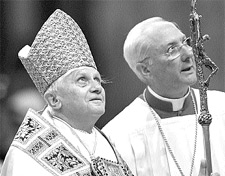 Found at the
Found at the “The Byzantine Divine Liturgy, like that of all the Eastern Churches, is celebrated facing East. The priest and all the faithful look to the East, whence Christ will come again in glory. The priest intercedes before the Lord for his people; he walks at the head of the people towards the encounter with the Lord. At different moments the priest turns to the people: for the proclamation of the Gospel, for the dialogue preceding the anaphora, for the communion with the holy gifts, and for all the blessings. These symbolize moments in which the Lord himself comes forth to meet his people.” – From the Office of Papal Liturgical Celebrations | Apostolic Journey of His Holiness Benedict XVI to
In the Presence of the Blessed Sacrament while meditating on, “Nothing that happens to us is contrary to the will of
I took a huge cross to my chest and placed it upon my right shoulder. Its weight and roughness dug into my flesh. I murmured, complaining about the pain. I then looked to the right, noticing that the majority of the cross didn’t even touch me. I bent to embrace its coarse bulk. With that embrace, my entire being easily accepted the discomfort. At that moment a hand gently touched my left shoulder. I sensed Who it was. I nodded, affirming His Presence, understanding His will.
Tuesday November 28
Meeting with President of Religious Affairs
Tuesday November 28
Meeting with Diplomatic Corps
Tuesday
Holy Mass from the House of Mary in
Wednesday November
Meeting with the Ecumenical Patriarch Bartholomew
Wednesday
Divine Liturgy at the Patriarchal
Thursday November 30
Visit to
Thursday
Holy Mass at the Cathedral of the Holy Spirit
Friday December
Departure
Friday December
 Most scholars agree that the Virgin Mary lived for a time in
Most scholars agree that the Virgin Mary lived for a time in The third Ecumenical Council of the Church was held in
The house of the Virgin was first discovered in 1881 by Abbe’ Gouyet, of
 Head over to Fr. Zulhsdorf's blog for his post after viewing the premier of The Nativity Story at the Vatican's Paul VI Audience Hall. His best observation, I believe, is found in the comments where he responds so wisely, "...this is a movie, not a theological treatise."
Head over to Fr. Zulhsdorf's blog for his post after viewing the premier of The Nativity Story at the Vatican's Paul VI Audience Hall. His best observation, I believe, is found in the comments where he responds so wisely, "...this is a movie, not a theological treatise."A man rushed into the doctor's office and shouted, "Doctor! I think I'm shrinking!" The doctor calmly responded, "Now, settle down. You'll just have to be a little patient."

 What Pope Benedict XVI will say in
What Pope Benedict XVI will say in Archbishop Dominique Mamberti, the
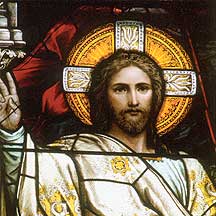 The Feast of Christ the King was created by Pope Pius XI in 1925. He created it to fix the way people were living like Jesus Christ didn't exist. The feast proclaims how Jesus Christ is royalty above people, communities, nations, and governments.
The Feast of Christ the King was created by Pope Pius XI in 1925. He created it to fix the way people were living like Jesus Christ didn't exist. The feast proclaims how Jesus Christ is royalty above people, communities, nations, and governments.Found at Adoro te Devote blog.
Lord Jesus Christ, I ask the grace to accept the sadness in my heart, as your will for me, in this moment. I offer it up, in union with your sufferings, for those who are in deepest need of your redeeming grace. I surrender myself to your Father's will and I ask you to help me to move on to the next task that you have set for me.
Spirit of Christ, help me to enter into a deeper union with you. Lead me away from dwelling on the hurt I feel:
to thoughts of charity for those who need my love
to thoughts of compassion for those who need my care, and to thoughts of giving to those who need my help.
As I give myself to you, help me to provide for the salvation of those who come to me in need.
May I find my healing in this giving.
May I always accept God's will.
May I find my true self by living for others in a spirit of sacrifice and suffering.
May I die more fully to myself, and live more fully in you.
As I seek to surrender to the Father's will, may I come to trust that he will do everything for me.
With Ecclesiastical Approval. Aadapted from the spiritual teachings of Rev. Walter J. Ciszek, SJ.
Official Organization for the Promotion of the Cause of Canonization
 I found this interesting bit of information in the Advent/Christmas 2006 issue of Latin Mass Magazine:
I found this interesting bit of information in the Advent/Christmas 2006 issue of Latin Mass Magazine:... A miraculous healing, attributed to the intercession of John Paul I, is being studied in Altamura-Gravina, a diocese in the southern Italian region of Puglie. Prior to his election in 1978, the Patriarch of Venice was being contested in his diocese by liberals who had gone so far as to ask the Vatican for his removal.It seems I am in good company! (I wonder if they gathered signatures on a petition.)

By The Universe: A Catholic aristocrat is trying to rehabilitate the memory of one of
Lady Angelika Cawdor, from
“The story of Macbeth is known throughout the world but it’s historically inaccurate,” said Lady Cawdor.
“Everyone thinks he was this ghastly character but it’s completely untrue. Macbeth was arguably
Last year was the 1,000th anniversary of Macbeth’s birth and this year marks the 400th anniversary of Shakespeare’s world-famous literary work.
“It would be nice to do something to mark these anniversaries,” explained Lady Cawdor.
“Shakespeare has been great for
She added: “We tell visitors to the castle he was nothing like the man portrayed in Shakespeare’s play.
“People also often presume Macbeth murdered
"In restless ecstasy.
After life's fitful fever he sleeps well.
Treason has done his worst; nor steel, nor poison,
Malice domestic, foreign levy, nothing,
Can touch him further." (Act
verumtamen inimicos meos illos qui noluerunt me regnare super se adducite huc et interficite ante me – Latin Vulgate
But as for those my enemies, who would not have me reign over them, bring them hither, and kill them before me. – Douay-Rheims
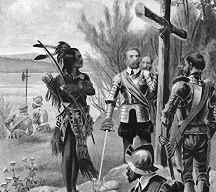 In April of 1541, [Catholic Conquistador Francisco] Coronado, with a group of soldiers and some missionaries … headed north-east and crossed a section of [what is now] northwest Texas (the Panhandle). In encountering some of the local Indians the missionaries found that the natives were immediately open to receiving the Gospel of Jesus Christ. After a few weeks of instruction, members of the Jumano Indian tribe converted and received Baptism. The expedition then arrived in Palo Duro Canyon where, on May 29, Father Juan Padilla, O.F.M., offered the Holy Sacrifice of the Mass. … A thanksgiving feast followed. It consisted of game that had earlier been caught. The feast was celebrated in thanksgiving to God for His many blessings and for the recent converts. This event is the first actual Thanksgiving Day celebrated in America by Christians. – from the soon-to-be published Journey America: Pathways to the Present by Andrew S. Miller, Marian Publications, Inc.
In April of 1541, [Catholic Conquistador Francisco] Coronado, with a group of soldiers and some missionaries … headed north-east and crossed a section of [what is now] northwest Texas (the Panhandle). In encountering some of the local Indians the missionaries found that the natives were immediately open to receiving the Gospel of Jesus Christ. After a few weeks of instruction, members of the Jumano Indian tribe converted and received Baptism. The expedition then arrived in Palo Duro Canyon where, on May 29, Father Juan Padilla, O.F.M., offered the Holy Sacrifice of the Mass. … A thanksgiving feast followed. It consisted of game that had earlier been caught. The feast was celebrated in thanksgiving to God for His many blessings and for the recent converts. This event is the first actual Thanksgiving Day celebrated in America by Christians. – from the soon-to-be published Journey America: Pathways to the Present by Andrew S. Miller, Marian Publications, Inc.
 “No Piero. You have it all wrong. It’s about our relationship with Him; the vertical intimacy between us and God, not a horizontal exchange among men, that is of primary importance.”
“No Piero. You have it all wrong. It’s about our relationship with Him; the vertical intimacy between us and God, not a horizontal exchange among men, that is of primary importance.” 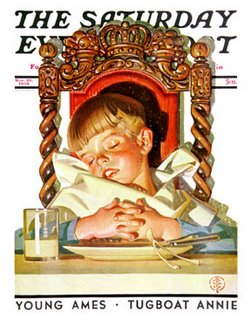 On this Thanksgiving Day, Lord, we Thy people count our blessings, which Thou hast given us. With joyful gratitude, we raise our voices in praise of the Author of Creation.
On this Thanksgiving Day, Lord, we Thy people count our blessings, which Thou hast given us. With joyful gratitude, we raise our voices in praise of the Author of Creation.We thank Thee for the gifts of life, free will, and good health of both body and mind.
We thank Thee for the bountiful food we eat, the warm clothes we wear, the shelter of our homes, the love and comfort of our families.
We thank Thee for gainful and challenging employment.
We thank thee for a free country, made prosperous by Thy grace and the effective exercise of our free will.
We thank Thee for the rights to earn our bread, speak our minds, elect our leaders, choose our friends, protect our families, and worship Thee.
We thank Thee for those who make our freedom possible: EMTs, doctors and nurses, firemen, policemen, soldiers, airmen, sailors, marines, Coast Guardsmen, agents, analysts, and national leaders.
We thank Thee for the sacrifice of so many brave young men and women who have given the last full measure of devotion, and for all who have served, so that we may live free in this land Thou hast provided for us.
We thank Thee for the gift of Faith which helps us to understand that we shall transcend all difficulties through Thy grace.
We thank thee for Thy Church here on earth, divided as it is, troubled by sin, beset by Satan, yet ultimately triumphant.
Most of all, Lord, we thank Thee for Thy Sacrifice on
We adore and thank Christ, Oh Christ, and we praise Thee, because by Thy holy cross, Thou hast redeemed the world. Amen.
 This prayer—originally written in 1959—was once again offered on
This prayer—originally written in 1959—was once again offered on Prayer for Renewal of Consecration
to Our Patroness of the
the Immaculate Conception
Most Holy Trinity: Our Father in Heaven, who chose Mary as the fairest of your daughters; Holy Spirit, who chose Mary as Your spouse; God the Son, who chose Mary as Your Mother; in union with Mary, we adore Your majesty and acknowledge Your supreme, eternal dominion and authority.
Most Holy Trinity, we put the
Mary, Immaculate Virgin, Our Mother, patroness of our land, we praise you and honor you and give our country and ourselves to your sorrowful and immaculate heart. O Sorrowful and Immaculate Heart of Mary, pierced by the sword of sorrow prophesized by Simeon, save us from degeneration, disaster and war. Protect us from all harm. O Sorrowful and Immaculate Heart of Mary, you who bore the sufferings of your Son in the depths of your heart, be our advocate. Pray for us, that acting always according to your will and the will of your divine Son, we may live and die pleasing to God. Amen.
 Roman martyr, patron saint of music. According to legend, St Cecilia was a Roman Christian from a patrician family who lived in the 2nd or 3rd century. She had decided to remain single and devote her life to God, but was forced into an arranged marriage. While the wedding guests danced at her wedding, she sat apart singing only the psalms. Valerian, her husband, turned out to be very understanding and respected her vow of virginity.
Roman martyr, patron saint of music. According to legend, St Cecilia was a Roman Christian from a patrician family who lived in the 2nd or 3rd century. She had decided to remain single and devote her life to God, but was forced into an arranged marriage. While the wedding guests danced at her wedding, she sat apart singing only the psalms. Valerian, her husband, turned out to be very understanding and respected her vow of virginity.He and his brother Tiburtius were both so impressed and attracted by Cecilia's graces, eventually they were both baptised. The family devoted themselves to charitable works including obtaining the bodies of martyred Christians and giving them decent burials. When the prefect Almachius found out what they were doing, he had them arrested and tried to force them to make sacrifices to the pagan gods. One of the soldiers who had interrogated them, a man called Maximus, was so struck by their conviction, he became a Christian too. The three men were put to death together.
St Cecilia buried them in the
Her house was later dedicated as a church by Pope Urban. In 1529 her tomb was opened and her body was found to be incorrupt. The sculptor Maderna made a life-size marble statue of her lying on her bed. A replica of this statue is on the site of her supposed tomb in
Since the 16th century, St Cecilia has been patron of musicians. The traditional account of her life can be found in Chaucer's Second Nun's Tale. The
 List will try to put Catholics on same page of hymnal
List will try to put Catholics on same page of hymnalDr. Philip Blosser offers this insightful post on his Musings of a Pertinacious Papist blog:
“I once privately related to my priest my frustration when trying to recollect myself before Communion and focus on Christ when eight Extraordinary Ministers of Holy Communion regularly file up from the ranks of the laity and self-consciously stand about the Altar looking a bit like nervous community theater actors auditioning for a part. We have a healthy, able-bodied priest at each Mass, and at least one deacon (sometimes two) on hand. The priest's attitude toward my complaint was very sympathetic, but his counsel was to "Offer it up."
“His counsel keeps surfacing as an unresolved question in my memory. "Offer it up"? Why offer this up? I could understand offering up the pain of arthritis, or the anguish of the death of a loved one -- something over which one has no control and can do little but pray. But if someone was, say, suffering from a troubled conscience because he was having an adulterous affair, would the priest counsel him to "Offer it up"?
“The problem here is that the sort of thing being permitted in our parish and parishes across the country are in direct violation of
[158.] Indeed, the extraordinary minister of Holy Communion may administer Communion only when the Priest and Deacon are lacking, when the Priest is prevented by weakness or advanced age or some other genuine reason, or when the number of faithful coming to Communion is so great that the very celebration of Mass would be unduly prolonged. This, however, is to be understood in such a way that a brief prolongation, considering the circumstances and culture of the place, is not at all a sufficient reason....
“In view of this, I struggle to make sense of my priest's counsel. It is not that I wish to be a doctrinaire knit-picking stickler about the letter of the law in these matters. In my view, the letter of the law is not the primary thing. The law is always a means in service of an end, which here is the purpose of liturgy: divine worship. What is of primary importance here, in my view, is the amplification of whatever faciliates divine worship, honors God and elevates and edifies the human heart, and the elimination of whatever does not.
“Yet perhaps there is one sense in which I can understand my priest's counsel. For whatever reason, circumstances are what they are. Whether the reason is because he may be afraid or unwilling to go against the tide of institutionalized liturgical abuses and make the mandated changes may be beside the point here. Given the status quo, I may lodge my objections with my priest and bishop, but then what? Have I any alternative but to "Offer it up"? My priest, perhaps despite himself and the Church's failure in self-administration, may have a point.”
Visit his blog to read the comments.

 King of East Anglia. On Christmas Day 855, at the age of 14, Edmund was declared King of Norfolk by the ruling men and clergy. In the following year, Suffolk also declared him to be their king. For the next 15 years he ruled over East Anglia with Christian dignity and justice. Edmund was noted for his piety and often recited the psalms during Masses.
King of East Anglia. On Christmas Day 855, at the age of 14, Edmund was declared King of Norfolk by the ruling men and clergy. In the following year, Suffolk also declared him to be their king. For the next 15 years he ruled over East Anglia with Christian dignity and justice. Edmund was noted for his piety and often recited the psalms during Masses. Ducking into confession with a turkey in his arms, Brian said, "Forgive me, Father, for I have sinned. I stole this turkey to feed my family. Would you take it and settle my guilt?"
Ducking into confession with a turkey in his arms, Brian said, "Forgive me, Father, for I have sinned. I stole this turkey to feed my family. Would you take it and settle my guilt?""Certainly not," said the Priest. "As penance, you must return it to the one from whom you stole it."
"I tried," Brian sobbed, "but he refused. Oh, Father, what should I do?"
"If what you say is true, then it is all right for you to keep it for your family."
Thanking the Priest, Brian hurried off.
"And yet, the new ICEL translations seem to be getting off the ground, certains bishops are now at least challenging the prevailing "wisdom" on liturgical music, and Cardinal Arinze at least is pushing Latin:
"In an hourlong, often humorous, address that received several standing ovations, Arinze suggested that, in order to give Catholics options, large parishes offer the Mass in Latin at least once a week, and in smaller, rural parishes, at least once a month.
"Rumours of a "universal indult" to liberalize the Mass of St. Pius V (the so-called "Tridentine" or "Latin" Mass) have advanced enough that the French Bishops have begun to panic. Rumours abound that the Anglican Use will be extended, in part I assume to prepare for an influx of traditionalist Episcopalians into the
"Even Gregorian chant seems to be making a comeback of sorts. Not in my parish, of course, where I'm currently on strike from the music of Häagen-Dazs Haugen and Haas. I haven't sung a hymn in two weeks. When I talked with some of our choir about this, I was told that nobody wants to go back to the "old music" because "it's hard to sing" and "we don't want to dictate, like they used to". The fact that they were dictating was lost on them."
Bede's astute observations, comments and post title, have me considering myself a "Counter-Reformationist." I like the sound of that. The bishops at the Council of Trent, Saint Pius V, and Saint Charles Borromeo, all Counter-Reformationists, would be appalled at the liturgies of today.
 John Bosco's Mother Is Decreed "Venerable" Margaret Occhiena, Co-founder of Salesian Family
John Bosco's Mother Is Decreed "Venerable" Margaret Occhiena, Co-founder of Salesian Family BALTIMORE (CNS) -- The U.S. Conference of Catholic Bishops Nov. 14 approved a statement on the pastoral care of homosexually inclined persons. The 26-page statement reiterates church teaching that all homosexual acts are morally wrong but affirms the dignity of those with homosexual inclinations and says that having such an inclination is not in itself sinful.
BALTIMORE (CNS) -- The U.S. Conference of Catholic Bishops Nov. 14 approved a statement on the pastoral care of homosexually inclined persons. The 26-page statement reiterates church teaching that all homosexual acts are morally wrong but affirms the dignity of those with homosexual inclinations and says that having such an inclination is not in itself sinful.
From Happy are those who are called to His Supper
Prayerful Recollection - We should prayerfully recollect ourselves prior to coming to Mass. We should strive to arrive on time, allowing ourselves to prepare our minds and hearts for the liturgy. Upon entering the church, we should maintain reverent silence so that we and those around us are able to pray before Mass begins. This will ensure that we are at peace within ourselves and with others. Such recollection helps to eliminate distractions and allows us to focus more easily on the great mystery of the Eucharistic celebration in which we are about to participate. A prayerful and reflective reading of the Scripture selections for the Mass of the day will help make our hearts and minds ready to receive God’s Word more deeply.
The Eucharistic Fast - We are required to keep the Eucharistic fast, that is, refraining from food and drink (except for water and medicines) for at least one hour prior to receiving Holy Communion. This fast demonstrates reverence and respect for the Body and Blood of Christ that we are going to receive. It also teaches us to hunger for Jesus in Holy Communion.
Appropriate Attire - We should also come to the sacred liturgy appropriately dressed. As Christians we should dress in a modest manner, wearing clothes that reflect our reverence for God and that manifest our respect for the dignity of the liturgy and for one another.
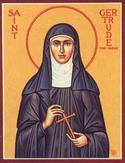 St. Gertrude the Great is invoked for souls in purgatory and for living sinners. Our Lord told St. Gertrude that the following prayer would release 1000 souls from purgatory each time it is said. The prayer was extended to include living sinners as well.
St. Gertrude the Great is invoked for souls in purgatory and for living sinners. Our Lord told St. Gertrude that the following prayer would release 1000 souls from purgatory each time it is said. The prayer was extended to include living sinners as well.
Gertrude was born